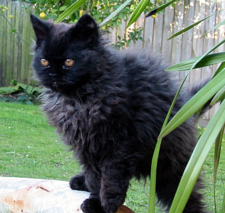|
The Scratching Post
Selkirk Rex 
Each hair on the Selkirk Rex has a gentle curl which gives the coat a soft feel. This medium to large cat is heavily boned which gives the cat surprising weight. The head is round, broad and full-cheeked. The muzzle is a medium width. The nose has a downward slant. The ears are medium in size, broad at the base and taper to a rounded tip. Eye color is independent of coat color. The back is straight with a slight rise to the hindquarters. The coat comes in two varieties: the shorthair and the longhair. The tail curls on the shorthairs are the same length as the coat which is about 1-2?. On the longhairs, the tail curls are plumy and stand out away from the tail. The ruff hairs that frame the face are longer.
|
|
Temperament
|
Selkirks are cute, cuddly and wonderfully loving companions. They are sweet, playful cats that love to be loved. Though they do not demand a lot of attention, they do seek it from their human families and love to receive it. The gentle Selkirk is a good family pet. They fit in well with other cats and cat-friendly dogs. They take life as it comes, and are easygoing, patient and adaptable. This breed enjoys being held, cuddled and will curl up in any available lap. They are neither destructive nor mischievous.
|
|
Weight
|
Male: 11-16 lbs. ; Female: 6-12 lbs.
|
|
Health Problems
|
The Selkirk is relatively free of serious health problems but make sure you purchase from a reputable breeder and that the breeder has screened for related health problems. Make sure you ask for a written health guarantee.
|
|
Living Conditions
|
Keeping your Selkirk indoors and in a protected environment is your cat?s safest recourse.
|
|
Exercise
|
Cats receive valuable exercise from playing. Playing builds the bond that you share as well as burns calories, releases aggression and burns off excess energy in younger cats.
|
|
Life Expectancy
|
About 10-15 years
|
|
Grooming
|
Selkirk Rexes need grooming, but tend to be more complicated than most breeds because combing straightens the curly coat. Ask your cat?s breeder to instruct you on proper grooming techniques.
|
|
Origin
|
The first Selkirk Rex, Curly-Q, was born at a shelter in Sheridan, Montana. She was blue-cream and white with a curly coat resembling lamb?s wool and was given to Peggy Vorrhees of the Bozeman Humane Society. Vorrhees then gave the unusual coated cat to longtime Persian breeder, Jeri Newman of Livingston, Montana. Newman was known for adopting cats that were in anyway unusual. Curly-Q, as plush and huggable as a child?s stuffed toy, was certainly that. Newman called the breed Selkirk, honoring her stepfather?s family name, and Rex to associate it with the other curly and wavy-coated breeds. Newman continued to breed the Selkirk by combining the best qualities of the Persian, Himalayan, British Shorthair, American Shorthair and the Exotic Shorthair in the bloodline. In 1990, only three years following the discovery of the new breed, the breed was accepted by the TICA. The CFA accepted the breed in 1992 and in record time, they had earned champion status in both registries.
|